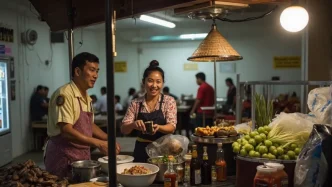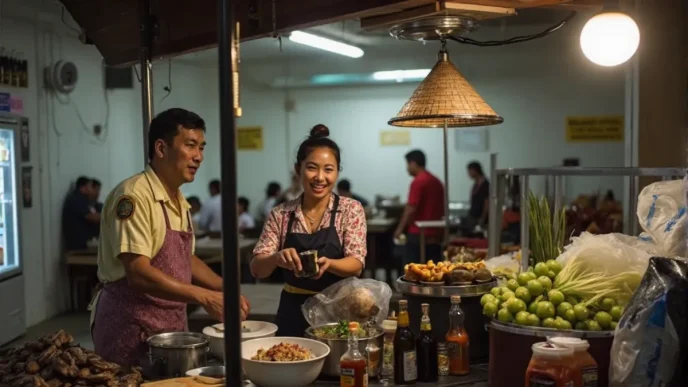As the rainy season sets in across Thailand, health officials are sounding the alarm over a significant uptick in Covid-19 cases, driven predominantly by the Omicron JN.1 variant. With over 211,000 cases and 51 deaths recorded in 2025 so far, the Department of Disease Control (DDC) is urging the public to remain vigilant, particularly as infections have surged past the five-year median in recent weeks. While the virus appears to be mutating into less severe forms, its rapid spread during this damp and cooler period poses new challenges for a nation still recovering from the pandemic’s earlier waves.
Surge in Cases Post-Songkran
The latest data from the DDC paints a concerning picture. Between May 18 and 24, Thailand reported 67,484 new Covid-19 cases and 8 deaths, contributing to a cumulative total of 211,717 cases and 51 fatalities for the year as of May 27. The spike follows the Songkran festival in April, a time of mass travel and communal celebrations that often fuels viral transmission. Since then, 14 infection clusters have been identified across the country, signaling localized outbreaks that could strain healthcare resources if unchecked.
Dr. Jurai Wongsawat, a spokesperson for the DDC, addressed the situation with a measured tone, emphasizing awareness over alarm. “People should be aware but not panic” said Dr. Jurai, noting that the mortality rate has remained low at 0.02% since the post-Songkran period. Most patients, he added, are experiencing mild symptoms, a trend attributed to widespread immunity from vaccinations and prior infections. However, the sheer volume of cases during weeks 19 to 21 of 2025—exceeding both the five-year median and last year’s figures for the same period—suggests the virus retains its ability to spread rapidly under favorable conditions.
Omicron JN.1 Dominates as Variants Evolve
Analysis from the Department of Medical Sciences reveals that the Omicron JN.1 variant is the primary driver of Thailand’s current wave, accounting for 63.92% of cases between January 2024 and May 6, 2025. Meanwhile, the XEC variant, once a concern, has dwindled to just 3.07% of infections. Other variants of concern are under close surveillance, though health officials note that newer strains do not appear to cause more severe illness. Instead, their increased transmissibility is the main worry, especially as seasonal factors come into play.
“The virus tends to mutate into less severe forms, but infections may rise during the rainy and winter seasons” said Dr. Jurai, highlighting a pattern seen in previous years. The rainy season, which typically spans May to October in Thailand, creates ideal conditions for respiratory viruses—crowded indoor spaces, higher humidity, and cooler temperatures all facilitate transmission. With schools reopening and daily life resuming in bustling urban centers like Bangkok, the risk of further spikes looms large.
Public Health Response and Challenges
Thailand’s public health system has come a long way since the early days of the pandemic, with robust vaccination campaigns and improved hospital capacity. Over 80% of the population has received at least two doses of a Covid-19 vaccine, according to data from the Ministry of Public Health, and booster shots are widely available for vulnerable groups. Yet, complacency remains a hurdle. Mask-wearing has declined in public spaces, and adherence to social distancing guidelines is often lax, particularly in densely populated areas like Bangkok’s Khlong Toei Market, where daily interactions are unavoidable for many street vendors and workers.
The DDC has ramped up public messaging, encouraging handwashing, mask-wearing in crowded settings, and prompt testing for those with symptoms. Hospitals have been instructed to monitor bed occupancy and ensure adequate supplies of antiviral medications, though no new lockdowns or mandatory restrictions are currently planned. This cautious approach reflects a broader shift in Thailand’s Covid-19 strategy—treating the virus as an endemic disease while preparing for periodic surges.
One pressing concern is the potential impact on the elderly and those with underlying health conditions, who remain at higher risk despite the virus’s reduced severity. Of the 51 deaths recorded this year, most have been among these groups, underscoring the need for targeted interventions. Health officials are also keeping a close eye on rural areas, where access to medical care can be limited, and vaccine hesitancy persists in some communities.
Economic and Social Implications
Beyond the immediate health concerns, the resurgence of Covid-19 carries economic and social ramifications for Thailand, a country heavily reliant on tourism and small businesses. The rainy season already dampens tourist arrivals in popular destinations like Phuket and Chiang Mai, and renewed fears of infection could further deter visitors. The Tourism Authority of Thailand reported a strong recovery in 2024, with over 28 million international arrivals, but sustained growth in 2025 hinges on maintaining confidence in the country’s health measures.
For street vendors and informal workers, many of whom operate in open-air markets like Khlong Toei, the stakes are personal. A single day of illness can mean lost income, and the cost of testing or treatment—while subsidized for Thai nationals—can still strain tight budgets. Government relief programs, scaled back since the height of the pandemic, offer limited support, leaving many to navigate the dual burden of health risks and financial precarity.
Public sentiment, gauged through social media platforms and local interviews, reveals a mix of resignation and concern. While few expect a return to the strict lockdowns of 2020 and 2021, there is unease about the virus’s persistence. “We’ve learned to live with it, but it’s still a worry when numbers go up like this” said a Bangkok resident who preferred anonymity. Health campaigns are now focusing on rebuilding trust and countering misinformation, particularly around vaccine efficacy and variant risks.
Regional Context and Global Lessons
Thailand’s experience mirrors broader trends across Southeast Asia, where countries like Vietnam and Indonesia are also grappling with seasonal Covid-19 upticks. The Omicron JN.1 variant has been dominant regionally, though local responses vary. Vietnam, for instance, has maintained stricter border controls and periodic mass testing in high-risk areas, while Indonesia has prioritized vaccine equity to close gaps in rural coverage. Thailand’s middle-ground approach—balancing normalcy with preparedness—offers a test case for managing an endemic virus in a tourism-driven economy.
Globally, the World Health Organization (WHO) continues to stress the importance of surveillance and data-sharing to track variant evolution. Thailand’s Department of Medical Sciences has contributed to these efforts, regularly updating genetic sequencing data to inform international research. The low mortality rate seen in Thailand aligns with global patterns for Omicron-derived variants, but the WHO warns that complacency could undo hard-won gains, especially as colder months approach in other hemispheres.
Looking Ahead: A Call for Resilience
As Thailand braces for potential further increases in Covid-19 cases during the rainy season, the message from health officials is clear: vigilance, not panic, is the way forward. With the Omicron JN.1 variant driving transmission but not severity, the focus remains on protecting the vulnerable and preventing healthcare systems from becoming overwhelmed. For ordinary Thais, from market vendors in Bangkok to farmers in Isaan, adapting to this new normal means balancing caution with the demands of daily life.
The coming weeks will test Thailand’s resilience, both in managing the virus and sustaining its economic recovery. As the rain continues to fall, so too does the question of whether public health measures can keep pace with a virus that refuses to fade away.
















